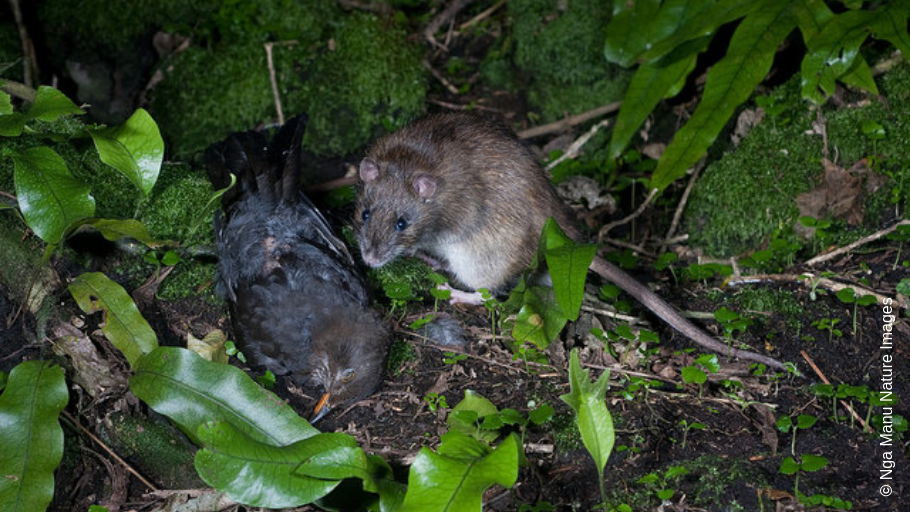D-Block bait and DITRAC All-Weather BLOX are two commonly used, long-life rodent baits with the same active ingredient, the anticoagulant Diphacinone. Rats and mice need to consume bait over several days to get a lethal dose, so it’s important to keep them coming back for more.

Although the toxin is the same, the two bait products have different physical designs and cereal contents. Is there one bait that rodents prefer?
Craig Morley and Ian McLean from the Ohomai Institute of Technology in Rotorua tested and compared the two bait products to find out what physical attributes and ingredients encourage maximum uptake by rats and therefore give the most efficient control. Their research has just been published in the New Zealand Journal of Ecology.
“When laid to control rodents near human habitation, toxic baits cannot be openly broadcast. Rather, toxins must be enclosed in bait stations that are tamper-resistant, designed to prevent baits from being removed, weather-proof, and inaccessible to companion animals and non-target species. They must also be designed so that the target species will enter and consume the baits. Further, the baits themselves must be manufactured to promote consumption, to minimise decay, reduce by-kill, and to prevent removal from the bait station.

Rats and mice have to want to eat the bait even when other food sources are available. If they don’t like what’s on offer, then it doesn’t matter how welcoming the bait station itself is, the control operation will fail, wasting time and money.
“To improve the efficacy of rodent control in municipal areas, we compared the consumption rates of two off-the-shelf rodenticides with the same active ingredients, but with different designs and cereal matrixes (Connovation D-Block® bait and Bell’s DITRAC All-Weather BLOX®) in two similarly sized locations to determine whether consumption rates of baits differed. Forty tracking tunnels were deployed pre and post bait deployment to determine the presence of rodents.”
The research was carried out in spring (August to October) 2014 at two sites, the Rotorua Lakes Council Landfill and Te Puia, a geothermal tourist attraction at the city boundary, 5 km from downtown Rotorua.
“The landfill is highly disturbed with little natural vegetation, and organic and inorganic waste arriving constantly throughout the day. Te Puia has a constant flow of tourists throughout the day and has little to no organic waste because groundkeepers are present. Te Puia has dense, low-growing (2–3 m) native vegetation dominated by mānuka, kānuka, prostrate kānuka and mingimingi and is accessible via a network of walking tracks. The two sites are 5 km apart, and the same stream flows through both.
“Prior to any toxic bait being distributed, 40 Gotcha® tracking tunnels (containing an ink pad) lured with peanut butter were placed beside buildings, walking tracks, rubbish bins, geothermal warm zones (at Te Puia), near the tip face (at the landfill), and along prominent animal runs.”
A total of 109 mouse, 55 rat and 46 cat tracks were detected in the pre-baiting tracking tunnels at the landfill, and 152 rat, 96 mouse and 11 cat tracks at Te Puia. More Norway rats were detected, particularly at Te Puia, than black rats.
Baits were then deployed in ‘rat café’ bait stations. Both bait products are cereal based and, because rats and mice are specialised gnawers, both D-Block and DITRAC are manufactured with multiple gnawing edges to encourage them to chew.
“One rat café® (an opaque plastic-moulded bait station designed by Connovation Ltd. to hold at least 4 bait blocks) was placed close to each of the 40 tracking tunnels at each site after the first week of tracking tunnel monitoring. To reduce any potential neophobic effects, baits were deployed in the cafés when the monitoring work ended two weeks later. Baits were checked daily and replaced as needed on three consecutive days for the following five weeks.”
Rodents ate more of the fragile Connovation D-Block® bait than Bell’s DITRAC All-Weather BLOX®.
“Measured as number of baits eaten, significantly more Conn baits than Bell baits were eaten in the cafés. Landfill: Conn, 218 of 600; Bell, 86 of 600. Te Puia: Conn, 269 of 600; Bell, 63 of 600. Connovation and Bell baits are made from similar materials. However, more Connovation bait may have been consumed because it was more fragile, making it easier to gnaw even though the Bell baits had more gnawing edges. We saw little or no bait residue in the rat cafés, indicating that the crumbs and fragments were eaten. If fragility aids rodents in consuming more bait, then this design feature might be key to encouraging increased bait uptake in future.”
No bait loss was detected at either site on the last few nights of the 5-week operation with post-baiting monitoring also indicating that a high kill rate had been achieved. Rats and mice consumed the bait even with the abundance of food choice on offer at the landfill site.
“For both baits, the initial amount of bait consumed was high but began to decline after 6–9 days of exposure, perhaps because more dominant rodents take the toxins first and more submissive rodents enter the bait stations as the dominants succumb to the baits. We hypothesise that using both baits in each bait station may deliver a higher kill rate than using a single bait type, thus saving time and money.”
“In conclusion, if a minority of rodents take an alternative bait when one is available, then the use of two baits could deliver a higher kill rate than for control situations in which only one bait is used. In a future trial, one rat café could be loaded with only Conn bait and another could be loaded with only Bell bait to ascertain if the rodents prefer one bait type over another as inferred by this study. Alternatively, as we found by using both baits within one bait station, the use of two baits may actually hasten rodent control.”
The full research report is published in the New Zealand Journal of Ecology and is freely available online.
Relative consumption of two commonly used rodenticides in New Zealand (2018)

